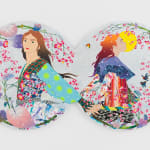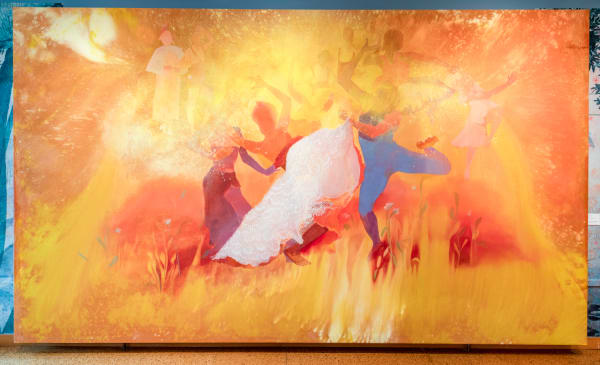274.3 x 487.7 cm
Tomokazu Matsuyama Japan, b. 1976
Wall To Wall With You, 2021
Acrylic and mixed media on canvas
92 x 48 x 2 inches
233.7 x 121.9 x 5.1 cms
233.7 x 121.9 x 5.1 cms
8319
Further images
-
(View a larger image of thumbnail 1
)

-
(View a larger image of thumbnail 2
)

-
(View a larger image of thumbnail 3
)

-
(View a larger image of thumbnail 4
)

-
(View a larger image of thumbnail 5
)

-
(View a larger image of thumbnail 6
)

-
(View a larger image of thumbnail 7
)

-
(View a larger image of thumbnail 8
)

-
(View a larger image of thumbnail 9
)

-

In this tondo by Tomokazu Matsuyama, we see two figures reaching across the canvas's divide and holding hands. The figures express gender ambiguous physical features, and don equally ambiguous clothing....
In this tondo by Tomokazu Matsuyama, we see two figures reaching across the canvas's divide and holding hands. The figures express gender ambiguous physical features, and don equally ambiguous clothing. They seem to be outdoors, but the background features a faint wallpaper pattern, suggesting that the outdoors has been brought in, or the indoors out. The menagerie of patterns on the figures' clothing ranges from decorative to references borrowed from art history. The white splatter on the surface of the painting is a ubiquitous element of Matsuyama's paintings. Suggestive of natural elements like snow or stars in the sky, it is created using a splatter technique evocative of Abstract Expressionism—yet another juxtaposition of alternate perspectives, in this case figuration versus abstraction.
Tondos are a significant platform within Tomokazu Matsuyama’s painting practice. He began developing his ongoing series of tondos around the time when he first transitioned from the field of large-scale public art into regularly exhibiting in museum galleries. The requirements imposed by the so-called “white cube” seemed to Matsuyama to be arbitrary and restrictive, and perhaps intended to force every artist to show their work in the same way. One apparent rule was that paintings should adhere to existing traditions in terms of their shape; a rule that Matsuyama intentionally subverts with every one of his shaped canvases, each being unique to its own composition. Another was the rule that paintings had to be exhibited at “eye-level,” a subjective and rather arbitrary concept.
“The shape of a tondo allows me to play around,” Matsuyama says, recalling times when he hung circular canvases of various sizes high up on walls, above doors, or in other unexpected places in order to confound the expectations of viewers.
Matsuyama has also experimented with a double tondo form, an idea which again came about through play, Matsuyama says. “I was painting on plates. Accessibility is a crucial language for me. I wondered, what if I blend two together, and it looked like an infinity sin. It worked. The tondo is a minimal form, which I like, and which relates to Western Minimalist painting, but this double tondo was also interesting because it resulted in something that was a bit more complex.”
The tradition of the circular painting, or tondo, relates to Western art history, and was especially popular amongst Renaissance painters in the 15th century. To Matsuyama, the form also relates to the Japanese tea ceremony. Japanese tea platters can be circular, or they can be shaped. They are not intended to be exactly the same. The Japanese tea house is also designed so you have to crouch to enter. The experience is intended to separate the participant from the rest of everyday life.
“You have to put away everything from society before you ever,” Matsuyama says. “When I create an exhibition, that is part of the whole experience I want to create. You have to put away what was in order to enter it. The tondo, the shaped canvas, wall applications—these are all ways to create this environment.”
Matsuyama’s tondos tend to center the figure in a way that evokes the work of Renaissance painters, which is another way that this body of work contributes to his overall conceptual framework of blending intercultural references. He is bringing together iconographies that welcome as many people as possible into his work. Rather than conveying a specific message or meaning, his works create spaces of introspection in which individual viewers are able to construct their own narrative, and find themselves in the work.
As with all of Matsuyama’s paintings, this painting incorporates a menagerie of Eastern and Western influences, embodying Matsuyama’s interest in intercultural exchange.
Matsuyama starts every new painting by perusing existing images of his dual worlds. He browses fashion magazines and advertisements looking for distinctively contemporary Western visual elements. He scans historic texts in search of visual cues to something older and idiosyncratically Japanese. From a broad mix of sources, he amalgamates scenes in which figures reminiscent of fashion models don clothing that evokes traditional Japanese garments while inhabiting backgrounds that echo Shogun-era screens, littered with the detritus of the modern city, such as, in this case, old shoes and fast food containers.
Whether outside milling in nature, lounging around a palatial mansion, or sitting inside a shabby apartment eating carryout, Matsuyama’s figures bear an immediate resemblance to the people we see every day in our neighborhood, in our Instagram feed, or in our mirror. Painted on curved canvases that simultaneously recollect mid-century Modernist Minimalism and ancient, shaped tea platters, these dreamlike visions express the struggle of reconciling the familiar local with the familiar global, and perfectly represent the essence of our cross-cultural, cross-temporal world.
“The convenience of our time has made how layered our culture is indefinite,” Matsuyama says. “When we see an image, we try to find connections. I accumulate all of this visual dialect and bring it together as though it has meaning, and the viewers make up a story based on their upbringing.”
Tondos are a significant platform within Tomokazu Matsuyama’s painting practice. He began developing his ongoing series of tondos around the time when he first transitioned from the field of large-scale public art into regularly exhibiting in museum galleries. The requirements imposed by the so-called “white cube” seemed to Matsuyama to be arbitrary and restrictive, and perhaps intended to force every artist to show their work in the same way. One apparent rule was that paintings should adhere to existing traditions in terms of their shape; a rule that Matsuyama intentionally subverts with every one of his shaped canvases, each being unique to its own composition. Another was the rule that paintings had to be exhibited at “eye-level,” a subjective and rather arbitrary concept.
“The shape of a tondo allows me to play around,” Matsuyama says, recalling times when he hung circular canvases of various sizes high up on walls, above doors, or in other unexpected places in order to confound the expectations of viewers.
Matsuyama has also experimented with a double tondo form, an idea which again came about through play, Matsuyama says. “I was painting on plates. Accessibility is a crucial language for me. I wondered, what if I blend two together, and it looked like an infinity sin. It worked. The tondo is a minimal form, which I like, and which relates to Western Minimalist painting, but this double tondo was also interesting because it resulted in something that was a bit more complex.”
The tradition of the circular painting, or tondo, relates to Western art history, and was especially popular amongst Renaissance painters in the 15th century. To Matsuyama, the form also relates to the Japanese tea ceremony. Japanese tea platters can be circular, or they can be shaped. They are not intended to be exactly the same. The Japanese tea house is also designed so you have to crouch to enter. The experience is intended to separate the participant from the rest of everyday life.
“You have to put away everything from society before you ever,” Matsuyama says. “When I create an exhibition, that is part of the whole experience I want to create. You have to put away what was in order to enter it. The tondo, the shaped canvas, wall applications—these are all ways to create this environment.”
Matsuyama’s tondos tend to center the figure in a way that evokes the work of Renaissance painters, which is another way that this body of work contributes to his overall conceptual framework of blending intercultural references. He is bringing together iconographies that welcome as many people as possible into his work. Rather than conveying a specific message or meaning, his works create spaces of introspection in which individual viewers are able to construct their own narrative, and find themselves in the work.
As with all of Matsuyama’s paintings, this painting incorporates a menagerie of Eastern and Western influences, embodying Matsuyama’s interest in intercultural exchange.
Matsuyama starts every new painting by perusing existing images of his dual worlds. He browses fashion magazines and advertisements looking for distinctively contemporary Western visual elements. He scans historic texts in search of visual cues to something older and idiosyncratically Japanese. From a broad mix of sources, he amalgamates scenes in which figures reminiscent of fashion models don clothing that evokes traditional Japanese garments while inhabiting backgrounds that echo Shogun-era screens, littered with the detritus of the modern city, such as, in this case, old shoes and fast food containers.
Whether outside milling in nature, lounging around a palatial mansion, or sitting inside a shabby apartment eating carryout, Matsuyama’s figures bear an immediate resemblance to the people we see every day in our neighborhood, in our Instagram feed, or in our mirror. Painted on curved canvases that simultaneously recollect mid-century Modernist Minimalism and ancient, shaped tea platters, these dreamlike visions express the struggle of reconciling the familiar local with the familiar global, and perfectly represent the essence of our cross-cultural, cross-temporal world.
“The convenience of our time has made how layered our culture is indefinite,” Matsuyama says. “When we see an image, we try to find connections. I accumulate all of this visual dialect and bring it together as though it has meaning, and the viewers make up a story based on their upbringing.”
Exhibitions
Tomokazu Matsuyama: The Best Part About Us, 2022. Kavi Gupta | Elizabeth St, Chicago, IL, USA
Share
- X
- Tumblr
Contact: +1 708-480-2882
General Inquiries: info@kavigupta.com
Media Inquiries: media@kavigupta.com
Client & Sales Inquiries: client@kavigupta.com
Publications: Kavi Gupta Editions
835 W. Washington Blvd. Fl 1-3 Chicago, IL 60607
Hours | Tue–Fri: 11 am–6 pm, Sat: 12 pm–5 pm
835 W. Washington Blvd. Fl 2 Chicago, IL 60607
Hours | Tue–Fri: 11 am–6 pm, Sat: 12 pm–5 pm
2025 Kavi Gupta
This website uses cookies
This site uses cookies to help make it more useful to you. Please contact us to find out more about our Cookie Policy.









